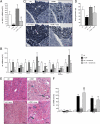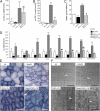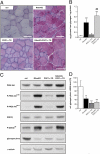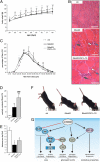Myopathy caused by mammalian target of rapamycin complex 1 (mTORC1) inactivation is not reversed by restoring mitochondrial function
- PMID: 22143799
- PMCID: PMC3251091
- DOI: 10.1073/pnas.1111448109
Myopathy caused by mammalian target of rapamycin complex 1 (mTORC1) inactivation is not reversed by restoring mitochondrial function
Abstract
Mammalian target of rapamycin complex 1 (mTORC1) is central to the control of cell, organ, and body size. Skeletal muscle-specific inactivation of mTORC1 in mice results in smaller muscle fibers, fewer mitochondria, increased glycogen stores, and a progressive myopathy that causes premature death. In mTORC1-deficient muscles, peroxisome proliferator-activated receptor gamma coactivator 1-α (PGC-1α), which regulates mitochondrial biogenesis and glucose homeostasis, is strongly down-regulated. Here we tested whether induction of mitochondrial biogenesis pharmacologically or by the overexpression of PGC-1α is sufficient to reverse the phenotype of mice deficient for mTORC1. We show that both approaches normalize mitochondrial function, such as oxidative capacity and expression of mitochondrial genes. However, they do not prevent or delay the progressive myopathy. In addition, we find that mTORC1 has a much stronger effect than PGC-1α on the glycogen content in muscle. This effect is based on the strong activation of PKB/Akt in mTORC1-deficient mice. We also show that activation of PKB/Akt not only affects glycogen synthesis but also diminishes glycogen degradation. Thus, our work provides strong functional evidence that mitochondrial dysfunction in mice with inactivated mTORC1 signaling is caused by the down-regulation of PGC-1α. However, our data also show that the impairment of mitochondria does not lead directly to the lethal myopathy.
Conflict of interest statement
The authors declare no conflict of interest.
Figures




Similar articles
-
Skeletal muscle-specific ablation of raptor, but not of rictor, causes metabolic changes and results in muscle dystrophy.Cell Metab. 2008 Nov;8(5):411-24. doi: 10.1016/j.cmet.2008.10.002. Cell Metab. 2008. PMID: 19046572
-
Skeletal muscle-specific expression of PGC-1α-b, an exercise-responsive isoform, increases exercise capacity and peak oxygen uptake.PLoS One. 2011;6(12):e28290. doi: 10.1371/journal.pone.0028290. Epub 2011 Dec 8. PLoS One. 2011. PMID: 22174785 Free PMC article.
-
mTOR controls mitochondrial oxidative function through a YY1-PGC-1alpha transcriptional complex.Nature. 2007 Nov 29;450(7170):736-40. doi: 10.1038/nature06322. Nature. 2007. PMID: 18046414
-
PGC-1 coactivators and skeletal muscle adaptations in health and disease.Curr Opin Genet Dev. 2008 Oct;18(5):426-34. doi: 10.1016/j.gde.2008.07.018. Epub 2008 Sep 7. Curr Opin Genet Dev. 2008. PMID: 18782618 Free PMC article. Review.
-
Rheb and mammalian target of rapamycin in mitochondrial homoeostasis.Open Biol. 2013 Dec 18;3(12):130185. doi: 10.1098/rsob.130185. Open Biol. 2013. PMID: 24352740 Free PMC article. Review.
Cited by
-
IL-6 regulation on skeletal muscle mitochondrial remodeling during cancer cachexia in the ApcMin/+ mouse.Skelet Muscle. 2012 Jul 6;2:14. doi: 10.1186/2044-5040-2-14. Skelet Muscle. 2012. PMID: 22769563 Free PMC article.
-
mTORC1 signalling is not essential for the maintenance of muscle mass and function in adult sedentary mice.J Cachexia Sarcopenia Muscle. 2020 Feb;11(1):259-273. doi: 10.1002/jcsm.12505. Epub 2019 Nov 7. J Cachexia Sarcopenia Muscle. 2020. PMID: 31697050 Free PMC article.
-
AKT controls protein synthesis and oxidative metabolism via combined mTORC1 and FOXO1 signalling to govern muscle physiology.J Cachexia Sarcopenia Muscle. 2022 Feb;13(1):495-514. doi: 10.1002/jcsm.12846. Epub 2021 Nov 9. J Cachexia Sarcopenia Muscle. 2022. PMID: 34751006 Free PMC article.
-
Mitochondrial Genetic Disorders: Cell Signaling and Pharmacological Therapies.Cells. 2019 Mar 28;8(4):289. doi: 10.3390/cells8040289. Cells. 2019. PMID: 30925787 Free PMC article. Review.
-
Differential response of skeletal muscles to mTORC1 signaling during atrophy and hypertrophy.Skelet Muscle. 2013 Mar 6;3(1):6. doi: 10.1186/2044-5040-3-6. Skelet Muscle. 2013. PMID: 23497627 Free PMC article.
References
-
- Glass DJ. Skeletal muscle hypertrophy and atrophy signaling pathways. Int J Biochem Cell Biol. 2005;37:1974–1984. - PubMed
-
- Wullschleger S, Loewith R, Hall MN. TOR signaling in growth and metabolism. Cell. 2006;124:471–484. - PubMed
-
- Bentzinger CF, et al. Skeletal muscle-specific ablation of raptor, but not of rictor, causes metabolic changes and results in muscle dystrophy. Cell Metab. 2008;8:411–424. - PubMed
-
- Um SH, et al. Absence of S6K1 protects against age- and diet-induced obesity while enhancing insulin sensitivity. Nature. 2004;431:200–205. - PubMed
Publication types
MeSH terms
Substances
LinkOut - more resources
Full Text Sources
Medical
Molecular Biology Databases
Miscellaneous

